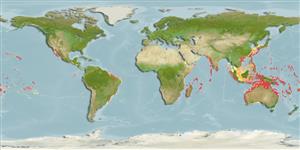Common names from other countries
Environment: milieu / climate zone / depth range / distribution range
Ecología
; rango de profundidad 0 - 82 m (Ref. 89006). Tropical
Atlantic, Indian, and Pacific Ocean.
Length at first maturity / Tamaño / Peso / Age
Maturity: Lm ? range ? - ? cm
Dead specimens washed up on beaches, and to 30 m (Ref. 377). Occurs on soft sediments, coral rubble, sand, rocky shores, and tidal pools at intertidal depths. Also on slabs of coral limestone and scattered reefs (Ref. 87907). Living at depths intertidally to 24 m (Ref. 89006). Single valves found on the beaches (Ref. 88739).
Life cycle and mating behavior
Madurez | Reproducción | Puesta | Huevos | Fecundidad | Larva
Members of the class Bivalvia are mostly gonochoric, some are protandric hermaphrodites. Life cycle: Embryos develop into free-swimming trocophore larvae, succeeded by the bivalve veliger, resembling a miniature clam.
Werner, T.B. and G.R. Allen. 2000. (Ref. 8295)
IUCN Red List Status (Ref. 130435)
CITES status (Ref. 108899)
Not Evaluated
Not Evaluated
Threat to humans
Harmless
Human uses
| FishSource |
Herramientas
Más información
Age/Size
Crecimiento
Length-weight
Length-length
Morfología
Larva
Abundancia
Fuentes de Internet
Estimates based on models
Preferred temperature
(Ref.
115969): 17.6 - 28.8, mean 27 (based on 1406 cells).
